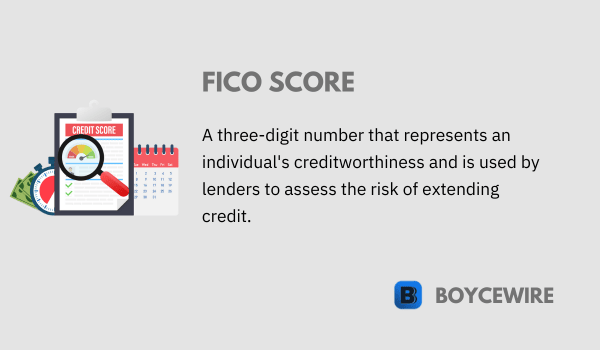FICO Score: What it is, & How to Check and Improve

What is a FICO Score?
FICO Score, an acronym for Fair Isaac Corporation Score, is a number that represents the creditworthiness of an individual and is used by lenders to assess the risk involved in lending money. It plays an instrumental role in many financial aspects of life, impacting everything from the interest rates on credit cards and loans, to the ability to secure rental agreements or even employment.
The concept of FICO Score was developed in 1989 by Fair Isaac Corporation, aiming to standardize the credit scoring process across lenders. Today, it is widely recognized as one of the most reliable indicators of credit risk. In essence, a higher FICO score opens up more opportunities for better financial products, while a lower score might restrict these options. Understanding how this three-digit number is determined, and how it can be influenced, is a crucial aspect of financial literacy. The following sections will delve into the constituents of the FICO score, how it is used, and how you can improve your own score.
Key Points
- FICO scores are credit scores developed by the Fair Isaac Corporation to assess an individual’s creditworthiness.
- FICO scores range from 300 to 850, with higher scores indicating better creditworthiness and lower credit risk.
- FICO scores are calculated based on factors such as payment history, credit utilization, length of credit history, types of credit used, and recent credit inquiries.
Components of a FICO Score
The FICO Score is computed using a complex algorithm, which analyzes multiple components of an individual’s financial history. Each of these components carries a different weight in the overall calculation of the score. Here are the five key components and their respective weights:
Payment History (35%)
The most significant component of the FICO score is the payment history, which involves the consistency and timeliness of your past payments. Late payments, defaults, bankruptcies, and other negative marks can significantly lower your score.
Amounts Owed (30%)
This component considers the total amount of debt you have in comparison to your credit limits. Keeping your balances low and maintaining a low credit utilization ratio can positively impact your score.
Length of Credit History (15%)
The longer you’ve been responsibly using credit, the better it is for your FICO score. This includes the age of your oldest credit account, the age of your newest credit account, and an average age of all your accounts.
Credit Mix (10%)
Having a variety of different types of credit, such as credit cards, mortgage loans, car loans, student loans, etc., can positively influence your score as it shows that you can handle different types of credit.
New Credit (10%)
Opening several new credit accounts in a short period can be risky and may lower your score. This component takes into account how many new accounts you’ve opened and how many new inquiries have been made on your credit.
It’s crucial to note that these percentages may vary slightly for different individuals, depending on the overall credit situation. Nevertheless, maintaining a healthy score means focusing on all of these components, rather than just one or two.
FICO Score Ranges and What They Mean
Understanding the ranges of FICO scores can be essential for setting financial goals, seeking loans, and understanding the terms that might be available based on your creditworthiness. Here are the typical ranges of FICO scores and what they generally mean:
- 800-850 (Exceptional): Borrowers with scores in this range are at the top of the credit score scale and are likely to be offered the best interest rates and terms for credit cards and loans.
- 740-799 (Very Good): Scores in this range are above the average score of U.S. consumers. Borrowers in this range may receive better than average interest rates from lenders.
- 670-739 (Good): This range is near or slightly above the average of U.S. consumers, and borrowers within this range are considered an “acceptable” borrower.
- 580-669 (Fair): Scores in this range are below the average score of U.S. consumers. While borrowers can still obtain credit in this range, they may be offered higher interest rates.
- 300-579 (Poor): Scores in this range are significantly below the average score of U.S. consumers. Borrowers may experience difficulty getting credit, and if they do, they are likely to get much higher rates.
It’s important to remember that these are just general guidelines and the impact of a particular score can vary between different lenders and types of credit products. Additionally, your credit score is not the only factor that lenders consider when deciding to extend credit or approve a loan. They also take into account factors such as income, employment stability, and overall debt levels.
How to Improve Your FICO Score
Improving a FICO score takes time, but starting with a few key strategies can help raise your score over time. Here’s how you can start:
- Pay Bills on Time: Late payments can significantly impact your FICO score. Consistently paying bills on time shows lenders that you’re reliable and can manage your finances responsibly.
- Reduce Debt: The amount of debt you owe can affect your credit score, particularly if your credit cards are near their limit. Try to reduce your balances and keep them low.
- Limit New Credit Applications: Applying for new credit can temporarily lower your FICO score. Unless necessary, try to limit new credit applications.
- Maintain a Healthy Credit Mix: Having a variety of credit types (like a mortgage, auto loan, and credit cards) can positively impact your FICO score, as long as you manage them well.
- Keep Old Credit Accounts Open: The length of your credit history contributes to your FICO score. If you close old credit accounts, it may shorten your credit history and negatively impact your score.
- Regularly Check Your Credit Report: It’s important to check your credit report regularly for any errors. If you find any inaccuracies, report them to the credit bureau immediately.
Remember, improving your FICO score is a process that takes time. But with consistent effort and responsible financial habits, it’s possible to see significant improvements. Always aim for a full understanding of any financial decisions and seek professional advice when needed.
How to Check Your FICO Score
There are several ways you can check your FICO score:
- Credit Card Issuers: Some credit card issuers offer free FICO score access to their cardholders. Check with your credit card issuer to see if this is a service they provide.
- Credit Counseling Services: Non-profit credit counseling services can provide you with a free credit report and FICO score. They can also help you understand your credit situation and offer guidance on how to improve it.
- Credit Reporting Agencies: The three major credit reporting agencies, Equifax, Experian, and TransUnion, offer FICO scores for purchase on their websites. Additionally, Experian offers FICO scores as part of their credit monitoring service.
- FICO Score Providers: You can purchase your FICO score directly from MyFICO, a service provided by the creators of the FICO score.
- Free Credit Score Services: Many online services provide free access to your credit score. However, be aware that these scores may not be FICO scores, as each service uses different scoring models.
Remember to ensure that any service you use to access your FICO score is reputable to protect your personal information. Also, under U.S. law, you’re entitled to one free copy of your credit report every 12 months from each of the three major credit reporting companies. However, this free report may not include your FICO score.
Common Misconceptions About FICO Score
- A single universal score: Many people believe there is one universal FICO score. In reality, there are many different versions of the FICO score. The scoring models may differ depending on the credit bureau and the specific type of loan you’re applying for (mortgage, auto loan, credit card, etc.).
- Checking your score lowers it: It’s a common myth that checking your own credit score will lower it. This is not true. You can check your own credit score as often as you like without it affecting your score. This is known as a “soft inquiry”. However, when a lender checks your score, it may slightly lower your score. This is known as a “hard inquiry”.
- Lower income means a lower score: Your income does not directly affect your FICO score. It’s how you manage your debts relative to your income that can impact your score.
- Age and marital status affect your score: Personal factors like age, race, nationality, marital status, and employment do not affect your FICO score. Credit scoring is based on objective factors related to your debt and payment history.
- You need to carry a credit card balance to build credit: You do not need to maintain a balance on your credit cards to build credit; in fact, it’s usually better for your credit score to pay off your balances in full each month. What’s important is that you have a credit history that shows responsible management of your credit over time.
- Closing old accounts will improve your score: Closing an old or inactive account may potentially hurt your credit score, especially if the account has a long positive history. The age of your oldest accounts is a factor in your credit score, so keeping old accounts open can be beneficial.
- All debts are the same: Not all debts are treated the same by the FICO scoring model. For example, a mortgage or student loan debt may be considered less risky compared to credit card debt.
Understanding these misconceptions can help you better understand how your FICO score works and how to take steps to improve or maintain your score.
Importance of FICO Score in Real World
- Credit and Loan Approvals: Your FICO score is a major factor in determining whether you’re approved for credit or a loan. Lenders use your score to assess the risk of lending you money. A high FICO score increases the likelihood that you’ll be approved for credit cards, mortgages, auto loans, and other types of loans.
- Interest Rates: Your FICO score doesn’t just affect your ability to get a loan—it also plays a large role in the interest rates you’re offered. Borrowers with higher FICO scores typically receive lower interest rates because they’re seen as less risky by lenders. Lower interest rates can save you a significant amount of money over the life of a loan.
- Rental Applications: Many landlords check potential tenants’ credit scores during the rental application process. A low FICO score can make it harder to rent a home, as it suggests to landlords that you may have difficulty paying rent on time.
- Insurance Premiums: Some insurance companies use credit-based insurance scores, which are partly based on your FICO score, to help determine premiums for auto and home insurance. A higher score can lead to lower premiums.
- Job Applications: Although employers do not see your FICO score, in some states in the U.S., they can check a modified version of your credit report as part of the job application process, especially for positions that require financial responsibility or access to sensitive financial information.
- Security Deposits: Utility companies, cell phone providers, and landlords may require a security deposit if your FICO score is low. A high score can potentially help you avoid these upfront costs.
Given its widespread use and impact, maintaining a high FICO score can open up opportunities, save you money, and generally make life easier. That’s why understanding what factors influence your FICO score and how to improve it is so important.
FAQs
A FICO score is a credit scoring model developed by the Fair Isaac Corporation, which is widely used by lenders to assess an individual’s creditworthiness.
FICO scores are calculated based on various factors, including payment history, credit utilization, length of credit history, types of credit, and recent credit inquiries.
FICO scores range from 300 to 850, with higher scores indicating better creditworthiness and lower credit risk.
Payment history and credit utilization have the most significant impact on a FICO score. Making on-time payments and keeping credit card balances low relative to credit limits can help maintain or improve a FICO score.
Consumers can access their FICO scores from various sources, including credit bureaus, credit card issuers, or by using online credit monitoring services.
About Paul
Paul Boyce is an economics editor with over 10 years experience in the industry. Currently working as a consultant within the financial services sector, Paul is the CEO and chief editor of BoyceWire. He has written publications for FEE, the Mises Institute, and many others.

Further Reading
 Pareto Principle: Definition, Pros, Cons & Examples - The Pareto Principle is the idea that 20% of causes lead to 80% of effects. In other words, a minority…
Pareto Principle: Definition, Pros, Cons & Examples - The Pareto Principle is the idea that 20% of causes lead to 80% of effects. In other words, a minority…  Why Free Markets are Important - According to the Collins Dictionary, a free market is an economic system that allows supply and demand to regulate prices,…
Why Free Markets are Important - According to the Collins Dictionary, a free market is an economic system that allows supply and demand to regulate prices,…  Exchange-Traded Fund (ETF): Definition, Pros, Cons & Examples - Exchange-traded funds, known as ETFs, is an investment fund which offers shares on the stock-market. Generally, ETFs specialize in indexes…
Exchange-Traded Fund (ETF): Definition, Pros, Cons & Examples - Exchange-traded funds, known as ETFs, is an investment fund which offers shares on the stock-market. Generally, ETFs specialize in indexes… 